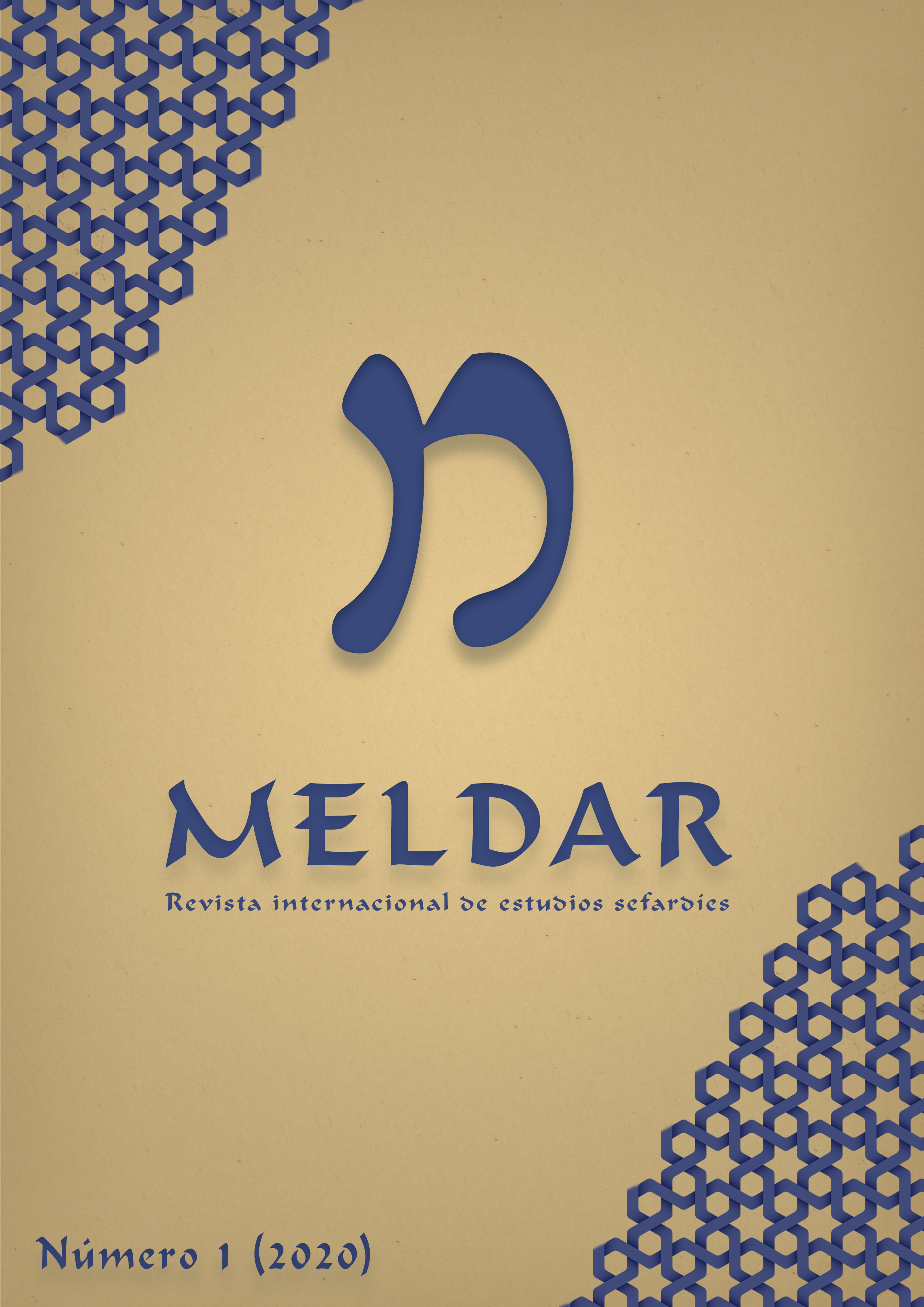Carro Triumphal: Pizarro, Genres and Jewish Historiography in 17th c. Amsterdam
DOI:
https://doi.org/10.46661/meldar.4901Palabras clave:
Historiografía judía x. XVII, sefardíes de Ámsterdam, Cesáreo carro triumphal, Antonio Pizarro de OliverosResumen
In this article there is an attempt to offer a new reading of the work entitled Cesáreo carro triumphal: En que gloriosamente campean por el orbe las invencibles armas del Maximo Emperador Leopoldo I. de este nombre, por la feliz restauración de la real fortaleza de Buda, conquistada en 2 de sept. de 1686 by Antonio Pizarro de Oliveros. Its components paratexts and ideas are analyzed. An historical and historiographic context is reconstructed to help in its comprehension.
Descargas
Citas
Aboab da Fonseca, Isaac. (1681). Parafrasis commentada sobre el Pentateuco. Amsterdam: Jacob de Cordova.
Asenjo, Julio Alonso. (2015). Festejos colegiales de los jesuitas de Valencia en el centenario de la fundación de la Compañía, 1640. Taller de TeatrEsco, 1, 1-21.
Boer, Harm den. (1988). Ediciones falsificadas de Holanda en el siglo XVII: Escritores sefarditas y censura judaica. In Varia bibliographica: homenaje a José Simón Díaz (pp. 99-104). Kassel: Reichenberger.
Bunes Ibarra, Miguel Angel de. (1988). La conquête et la libération de Buda dans les pensées des Espagnols. Acta Historica Academiae Scientiarum Hungaricae, 34(1), 47-56.
Caro Baroja, Julio. (1978). Los judíos en la España moderna y contemporánea. Madrid: Istmo.
Díaz Esteban, Fernando. (1997a). La retirada turca de Buda(-pest) en 1686 vista por el lado europeo. Boletín de la Asociación Española de Orientalistas, 155-173.
Díaz Esteban, Fernando. (1997b). La fidelidad judía a las autoridades: un Memorial de cuando la pérdida turca de Buda en 1686. Sefarad, 57(2), 227-250.
Domínguez Guzmán, Aurora. (1988). Relaciones de autos de fe impresas en el siglo XVII. In Varia bibliographica: homenaje a José Simón Díaz (pp. 217-230). Kassel: Reichenberger.
Duarte Lueiro, J. Enrique. (2005). Poesía e historia en La Restauración de Buda de Francisco Bances Candamo. In Isabel Ibañez (Ed.), Similitud y verosimilitud en el teatro del Siglo de Oro (pp. 283-307). Pamplona: EUNSA (Anejos de Rilce, 52).
Ettinghausen, Henry. (2015). How the Press Began. The Pre-Periodical Printed News in Early Modern Europe. A Coruña: SIELAE Facultad de Filología, Universidade da Coruña.
Fernández Marcos, Natalio. (1994). José Semah Arias traductor de Flavio Josefo. In Fernando Díaz Esteban (Ed.), Los judaizantes en Europa y la literatura castellana del siglo de Oro (pp. 141-154). Madrid: Letrinumero.
Grunwald, Max Samuel. (1913). Oppenheimer und sein Kreis. Viena.
Goldenberg, David M. (1999). Geographia Rabbinica: The Toponym Barbaria. Journal of Jewish Studies, 50, 53-73.
Gutwirth, Eleazar. (1988). The Expulsion of the Jews from Spain and Jewish Historiography. In Ada Rapoport-Albert & Steven J. Zipperstein (Eds.), Jewish History: Festschrift Chimen Abramsky (pp. 141-161). London: Peter Halban.
Gutwirth, Eleazar. (2001). Penso’s Roots: The Politics and Poetics of Cultural Fusion. Studia rosenthaliana, 35(2), 269-284.
Gutwirth, Eleazar. (2003). Historians in Context-Jewish Historiography in the Fifteenth and Sixteenth Centuries. Frankfurter Judaistische Beitraege, 30, 147-168.
Gutwirth, Eleazar. (2012). De la geografia literaria a la geografia historica (ss. XV-XVI). In Manuel Casado Velarde, Ruth Fine & Carlos Mata Induráin (Eds.), Jerusalen y Toledo historias de dos ciudades (pp. 133-144). Madrid-Frankfurt: Iberoamericana-Vervuert.
Gutwirth, Eleazar. (2013). Crossing the Borders of Modernity:Towards a Context for Al-Gharnati (Leo Africanus). MEAH, 62, 83-114.
Gutwirth, Eleazar. (2015). The Most marueilous historie of the Iewes: Historiography and the “Marvelous” in the Sixteenth Century. In Michelle M. Hamilton & Núria Silleras Fernández (eds.), In and Of the Mediterranean: Medieval and Early Modern Iberian Studies (pp. 157-182). Nashville, TN: Vanderbilt University Press.
Gutwirth, Eleazar. (2020). The Three Rings: Shevet Yehuda-Lessing / Graetz-Fritz Ishaq Baer. In Mercedes García-Arenal & Stefania Pastore (Eds.), From Doubt to Unbelief: Forms of Scepticism in the Iberian World (pp. 46-64). Cambridge: Legenda.
Hanny, Erzsébet. (2013). Las noticias de la guerra contra turcos en Hungría y en Buda en las relaciones españolas del siglo XVII. In Pedro Manuel Cátedra García & María Eugenia Díaz Tena (Eds.), Géneros editoriales y relaciones de sucesos en la Edad Moderna (pp. 211-229). Salamanca: SIERS.
Hanny, Erzsébet. (2015). Toma de Buda en 1686 y los cambios políticos y sociales en reflejo de relaciones de sucesos españoles. Studia aurea monográfica, 6, 283-295.
Hernández-Pecoraro, Rosilie. (2005). Cristóbal Suárez de Figueroa and Isabel Correa: Competing Translators of Battista Guarini’s “Il Pastor Fido”. Romance Notes, 46(1), 97-105.
Hernández-Pecoraro, Rosilie. (2004). Isabel Correa: traducción transformativa de Il Pastor fido de Guarini. In Isaías Lerner, Roberto Nival & Alejandro Alonso (eds.), Actas XIV Congreso AIH, 2 (pp. 291-297). Brunswick, NJ: Juan de la Cuesta.
Herrero Sánchez, Manuel. (2016). Conectores sefarditas en una Monarquía policéntrica. El caso Belmonte/Schonenberg en la articulación de las relaciones hispano-neerlandesas durante la segunda mitad del siglo XVII. Hispania, 76(253), 445-472.
Hummelberger, Walter. (1987). Die Bewaffnung, Ausrüstung und Versorgung der Truppen der „Heiligen Liga“ bei der Belagerung von Buda 1686. Acta Historica Academiae Scientiarum Hungaricae, 33(2-4), 319-332.
Kaufmann, David. (1895). Die Erstuermung Ofens. Trier: Mayer.
Kaufmann, David. (1908-1910). Gesammelte Schriften. Frankfurt: Kauffmann.
Kayserling, Meyer. (1890). Biblioteca española-portugueza-judaica. Strassburg: C. J. Trubner.
Kohn, S. (1887). Eine angebliche Denkschrift der jüdischen Bevölkerung Ofens. 1686. Szazadok. 21, 827-836.
Lanini Sagredo, Pedro. (2017). La restauración de Buda. Auto sacramental alegórico [Ed. Ignacio Arellano]. Pamplona: Universidad Navarra.
Leonetti, Francesca. (2015). El conflicto entre cristianos y musulmanes en las relaciones de sucesos: la liberación de Buda. En Jorge García López, Sònia Boadas Cabarrocas (eds.) Las relaciones de sucesos en los cambios políticos y sociales de la Europa Moderna (pp. 309-322). Bellaterra: Studia Aurea Monográfica.
López Estrada, Francisco. (1994). Poética barroca. Edición y estudio de los preliminares de El Pastor Fido de Guarini, traducido por Isabel Correa (1694). In Francis Cerdan (Ed.), Hommage à Robert Jammes, 2 (pp. 739-753). Toulouse: Presses Universitaires du Mirail.
Luzzatto, Simone. (1950). Maʼamar ʻal Yehude Ṿeneṭsyah [tirgem meha-maqor ha-Iṭalḳi, Dan Laṭes; ʻim mevoʼot meʼet Riḳardo Binyamin Baḳi u-M. A. Shulṿas]. Jerusalem: Mosad Byaliḳ.
Mangold, L. (1887). Ungarn. Jahresberichte der geschichtswissenschaft, 10, 133.
Moolick, Charles James. (1964). The Poetic Styles Of Miguel De Barrios. University of Southern California: ProQuest Dissertations Publishing.
Offenberg, Adri K. (2012). The First Jewish Poem in Praise of the City of Amsterdam by David Jesurun, ‘El Poeta Niño’. Studia Rosenthaliana, 44, 217-220.
Pach, Hilde. (2008). “In Hamburg a high German Jew was murdered”: The representation of foreign Jews in the Dinstagishe Un Fraytagishe Kuranten (Amsterdam, 1686-1687). En Yosef Kaplan (Ed.), The Dutch intersection: the Jews and the Netherlands in modern history (pp. 213-224). Leiden-Boston: Brill.
Penslar, Derek. (1997). The Origins of Jewish Political Economy. Jewish Social Studies, 3(3), 26-60.
Pizarro de Oliveros, Antonio. (1687). Cesareo carro triumphal: En que gloriosamente campean por el orbe las invencibles armas del Maximo Emperador Leopoldo I. de este nombre, por la feliz restauración de la real fortaleza de Buda, conquistada en 2. de sept. de 1686. Amsterdam: Jacob de Cordova.
Ratti, Anna Maria. (1961). Vita e opere di Riccardo Bachi. Milano: A. Giuffrè.
Ravid, Benjamin C. I. (1978). Economics and Toleration in Seventeenth Century Venice. The Background and Context of the Discorso of Simone Luzzatto. Jerusalem: American Academy for Jewish Research.
Réthelyi, Orsolya. (2014). Buda’s Reconquest (1686) and the Image of Hungarians, Ottomans and Habsburgs in Seventeenth-Century Dutch Drama. In Kees Teszelszky (Ed.), A Divided Hungary in Europe: Exchanges, Networks, and Representations, 1541−1699, 3: The making and uses of the image of Hungary and Transylvania (pp. 167-194). Newcastle: Cambridge Scholars Publishing.
Sánchez Jiménez, Antonio. (2017). Miguel de Barrios y la conquista de Buda: los poemas preliminares al Cesáreo carro triunfal (1687). Bulletin of Spanish Studies, 94(2), 201-223.
Schnitzer, Shmuel. (1987). U-ve-khol zot ha-bekhora shayekhet la-’Gazeta’. Kesher, 2, 3-10.
Schulhof, Isaac Ben Zalman Ben Moses, Ferenc Szakály, Izsak & Agostini, Paolo. (1982). La Meghillà di Buda: 1686. Roma: Carucci.
Silvera, Miriam. (1991). Contribution à l’examen des sources de L’Histoire des Juifs de Jacques Basnage: Las Excelencias de los Hebreos de Ysaac Cardoso. Studia Rosenthaliana, 25(1), 42-53.
Veltri, Giuseppi. (2009). Renaissance Philosophy in Jewish Garb. Leiden: Brill.
Verga, Solomon Ibn. (1744). Vara de Juda. Amsterdam.
Vidorreta, Almudena. (2017). Poesía amorosa de una erudita del XVII: traducción y creación en El Pastor Fido de Isabel Correa. Revista de Filología Española, 97, 175-203.
Weinberger, Carmilly. (1981). The Ransoming of Jewish Captives in the 17th Century in Hungary. In Proceedings of the World Congress of Jewish Studies, B (pp. 77-83).
Weinstein, Rochelle. (1992). Stones of Memory: Revelations from a Cemetery in Curacao. American Jewish Archives, 44(1), 81-140.
Descargas
Publicado
Cómo citar
Número
Sección
Licencia
Derechos de autor 2020 Meldar: Revista internacional de estudios sefardíes

Esta obra está bajo una licencia internacional Creative Commons Atribución-NoComercial 4.0.
Las obras se publican en la edición electrónica de la revista bajo una licencia Creative Commons Reconocimiento-NoComercial-4.0 Internacional: se pueden copiar, usar, difundir, transmitir y exponer públicamente, siempre que:
- Se cite la autoría y la fuente original de su publicación (revista, editorial y URL de la obra).
- No se usen para fines comerciales.
- Se mencione la existencia y especificaciones de esta licencia de uso.




 @meldar__
@meldar__


